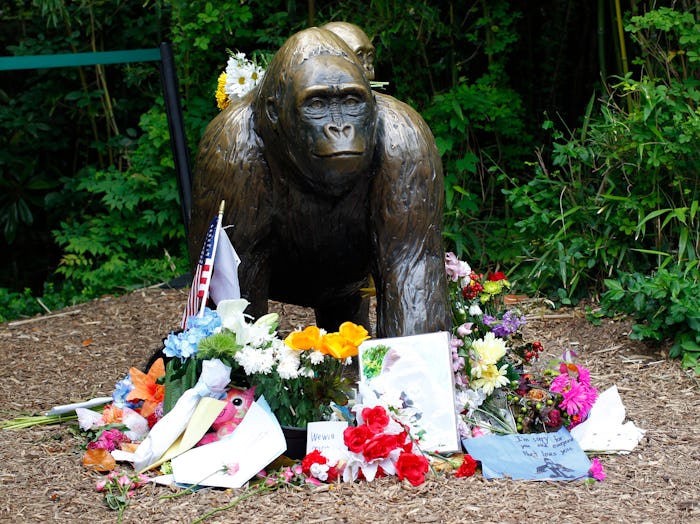News

Cincinnati Zoo Replaces Gorilla Barrier Fence & It's Definitely A Smart Move
Little more than a week after it opted to shoot and kill an endangered gorilla in order to protect a young boy who entered the enclosure, the Cincinnati Zoo will reopen Tuesday, June 7 — but not without enhanced safety standards. Although the zoo's director said the current "Gorilla World" barrier "goes above and beyond standard safety requirements", the zoo will replace the gorilla barrier fence. Considering the fact that 17-year-old Harambe lost his life when the boy breached the barrier (and that the boy, who is mostly fine, could have been seriously injured or killed by the 450-pound wild animal), this is definitely a smart move.
The controversy was ignited on Saturday, when a 4-year-old boy who had previously expressed a desire to enter the gorilla enclosure managed to do so by crawling through a barrier and more than five feet of bushes before falling about 10 to 12 feet into a moat. The 4-year-old spent about 10 minutes in the enclosure as Harambe dragged him through the water and stood over him. Although the western lowland gorilla did not overtly attack the boy, zookeepers determined that his size and strength posed an imminent danger and made the call to shoot him with a rifle while the boy was between his legs.
Since then, the boy's mother, Michelle Gregg, has come under public attack as many believe she had been neglectful by not watching her child closely enough. Others quickly blamed the zoo: Washington Post op-ed columnist Lori Gruen wrote that zoos are intrinsically deleterious to animal welfare. The editorial board at the The New Jersey Star-Ledger, meanwhile, simply opined that "This is about constructing secure, human-proof pens. And in this case, the zoo's failure was appalling."
But the Cincinnati Zoo's Gorilla World barrier at the time of the incident adhered to strict safety guidelines and passed multiple inspections by the Association of Zoos and Aquariums (AZA). The new barrier, though, will be the same one that the zoo employs to keep human and beast separated at its lion exhibit, WCPO Cincinnati reported. In a statement, the zoo described the new barrier as 42 inches high "with solid wood beams at the top and on the bottom with knotted rope netting."
Regardless of who's at fault for the boy's being able to get through the protective barrier and Harambe's subsequent tragic death, improving safety measures at the zoo is certainly a laudable measure on the zoo's part. Although instances of people entering zoo enclosures are incredibly rare, they do happen.
In May of 1987, for example, a boy intending to swim in the moat surrounding the polar bear exhibit at the Prospect Park Zoo in Brooklyn died when two of the animals mauled him. At the Pittsburgh Zoo in 2012, a 2-year-old boy was fatally mauled by wild dogs after falling into the exhibit. His mother at lifted him onto the ledge so he could get a better look. On a less gruesome note, when a 3-year-old boy fell into the primate exhibit at a Chicago zoo in 1996, a gorilla carried him safely to zookeepers.
Patrick Janikowski, principal of PJA Architects, told CNN that a moat like the one the Cincinnati Zoo has is a good way to separate human and animals. Heavy mesh or glass enclosures can work well, too, he said, especially if space is limited.
It's hard to say what exactly could have prevented these accidents short of abolishing zoos altogether. While Harambe's death has proved to be incredibly controversial and polarizing, the best course of action from here is to focus on ensuring that a similar situation doesn't arise in Cincinnati or anywhere else. It's imperative that zoo patrons understand and follow zoo safety rules, and that the construction of zoo enclosures continues to evolve to keep people and animals safe.